Different Wasps in Texas: Exploring Varieties and Behaviors
Key Takeaways
- Texas hosts diverse wasp species due to its varied habitats and warm climate.
- Understanding these different wasps is crucial for effective pest management in Texas.
- Key Texas wasp types include yellow jackets, paper wasps, mud daubers, cicada killers, and tarantula hawks, each with unique behaviors and roles in the ecosystem.
As a pest control expert, I frequently encounter homeowners surprised by the sheer diversity of wasps in Texas. With its varied habitats and warm climate, the Lone Star State provides a haven for many different wasp species. Understanding these “different wasps in Texas” is crucial for effective pest management strategies. By recognizing the types of wasps present and their behaviors, homeowners can take informed actions to protect themselves and their property.
Types of Wasps in Texas
Texas boasts a rich tapestry of wasp species, each with unique characteristics and ecological roles. Here’s a closer look at some of the most common:
Yellow Jackets
These social wasps are notorious for their yellow and black bodies and aggressive behavior. They build paper nests underground or in sheltered areas and are attracted to sweet drinks and food scraps. Their stings pack a punch and can be dangerous, especially for people with allergies.
- Look for: Black and yellow striped body with a narrow waist.
- Beware: Aggressive, especially around nests or sweet food. Their stings are painful and dangerous for people with allergies.

Paper Wasps
Often confused with yellow jackets, paper wasps have a slender body with reddish-brown or yellow markings. They construct distinctive paper nests in exposed locations like eaves and trees. While they can sting, paper wasps are generally less aggressive than yellow jackets.
- Look for: Slender body with reddish-brown or yellow markings and a broader waist compared to yellow jackets. Also, identify their paper nests in exposed locations like eaves, trees, or under porch roofs.
- Less aggressive than yellow jackets, stinging only if threatened.

Mud Daubers
Solitary wasps, mud daubers are easily identifiable by their long, slender bodies and black coloration. They construct unique nests from mud, often in sheltered areas like porches and garages. Unlike their aggressive counterparts, mud daubers are beneficial predators of spiders and other insects and rarely sting humans.
- Look for: Long, slender black bodies and the lack of a stinger-like appendage at the tip. They also build unique nests from mud, often in sheltered areas like porches, garages, or attics.
- Beneficial predators that help control spider populations and rarely sting humans.
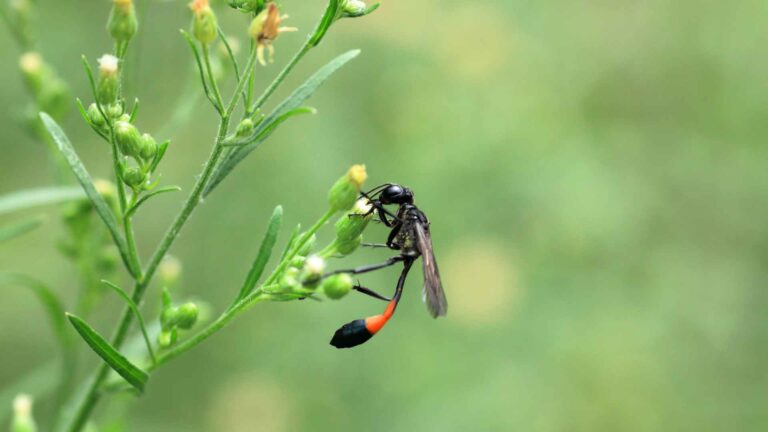
Cicada Killers
These giants of the wasp world are the largest wasps found in Texas. They boast a black and yellow body and are solitary hunters of cicadas. Cicada killers paralyze cicadas and store them in underground burrows as food for their developing larvae. Despite their size, cicada killers are not aggressive towards humans and pose minimal threat.
Look for: The largest wasps in Texas, with black and yellow bodies. Notice them hovering near trees or digging in the ground.

Tarantula Hawks
Another impressive wasp, the tarantula hawk is a solitary predator that specializes in hunting tarantulas. They are wasp royalty, boasting a metallic blue body and large orange wings. While their sting is incredibly painful, tarantula hawks are not aggressive towards humans and play a vital role in controlling tarantula populations.
- Look for: Stunning metallic blue body and large orange wings.
- Not aggressive towards humans, despite their impressive size.
Schedule a pest control consultation to secure your home today.
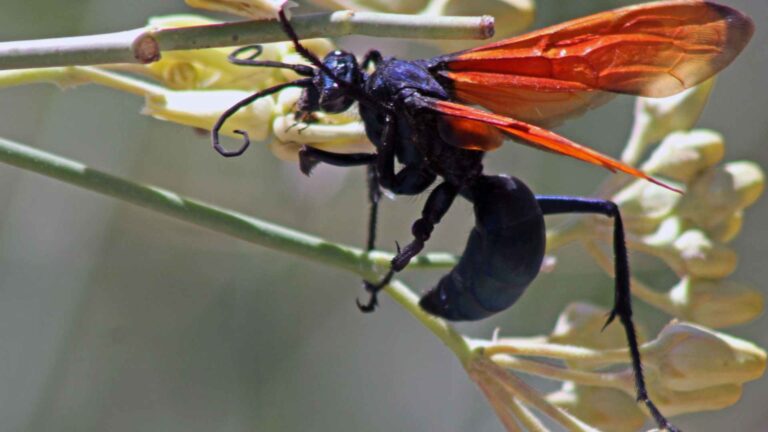
Behavior and Life Cycle of Texas Wasps
Despite their differences, most Texas wasps share some common behaviors. They are all predators, feeding on insects and other invertebrates.
Wasps are also beneficial pollinators, contributing to the health of flowering plants. Their life cycle typically follows four stages: egg, larva, pupa, and adult. However, it’s crucial to manage their presence near pools or chimneys to avoid conflicts and ensure safety
Each stage plays a vital role in the wasp’s development and overall contribution to the ecosystem. Wasp activity and nesting patterns often fluctuate throughout the year, with peak activity occurring during the warmer months.
Wasp Nests in Texas
Yellow Jacket Nests
- Description: Yellow jacket nests are constructed from a papery material made of chewed wood pulp and saliva. They have a round or oval shape with a gray or brown color and appear honeycomb-like with exposed cells inside.
- Location: Yellow jackets build their nests underground in burrows, wall voids, or other sheltered areas.
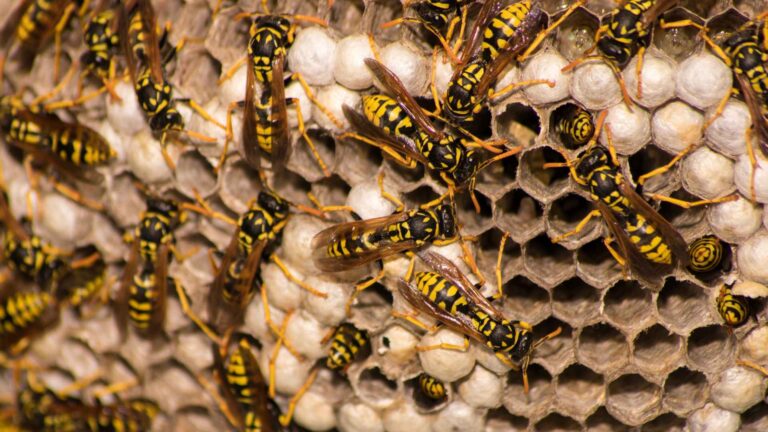
Paper Wasp Nests
- Description: Paper wasp nests are also constructed from papery material but have a more distinctive appearance. They are single or multi-comb structures with an umbrella or hanging basket shape. The nest itself is gray or brown, with open cells visible on the underside.
- Location: Paper wasps prefer exposed locations like eaves, under overhangs, trees, or shrubs.
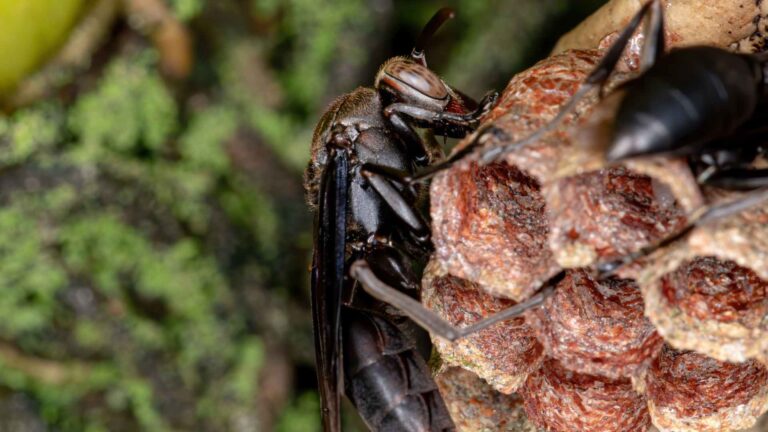
Mud Dauber Nests
- Description: Mud daubers, unlike other wasps, construct their nests entirely from mud. These nests are small, tubular structures with a bumpy surface, often clustered together. They may be brown or match the color of the surrounding mud.
- Location: Mud daubers build their nests in sheltered areas like porches, garages, attics, or underneath eaves.
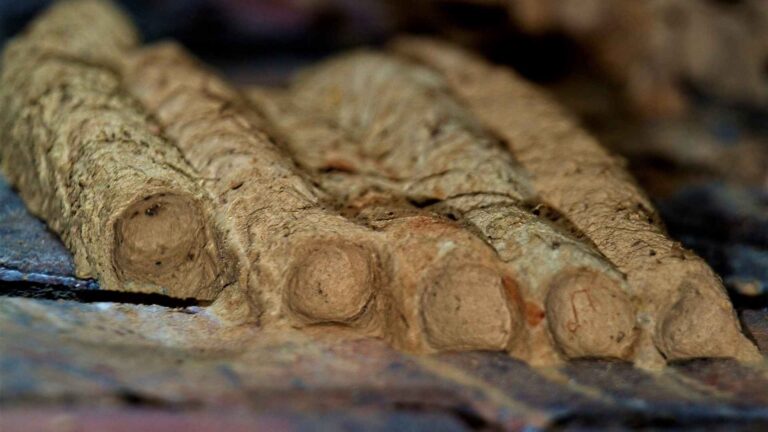
Cicada Killer Burrows
- Description: Cicada killers don’t construct nests above ground. Instead, they create burrows underground where they store paralyzed cicadas as food for their larvae. You might notice a small opening in the ground with a loose pile of dirt around it.
- Location: Cicada killers burrow in sandy or loose soil, often near trees where cicadas are abundant.
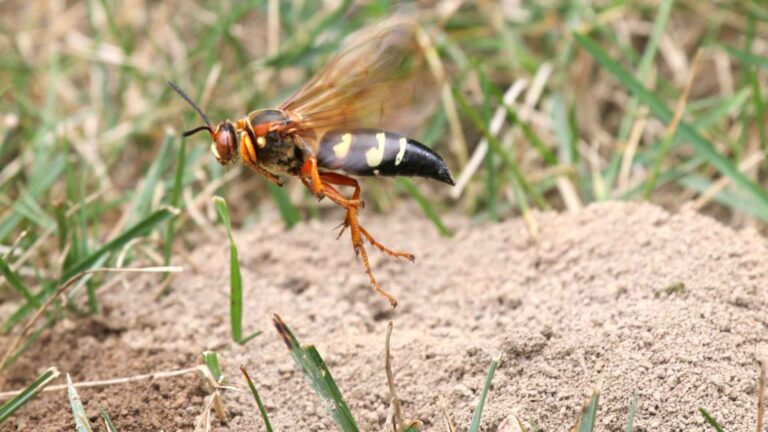
Tarantula Hawk Nests
- Description: Tarantula hawks are solitary wasps and don’t build their own nests. They utilize pre-existing cavities like abandoned rodent burrows or spider holes to lay their eggs and store captured tarantulas.
- Location: Tarantula hawks are found in areas with tarantula populations. They might be seen inspecting burrows or digging in the ground to locate suitable nesting sites.
Important Note: Regardless of the type of wasp nest, it’s best to avoid approaching them closely. If a wasp nest is located near a high-traffic area or your home, consider contacting a pest control professional for safe removal.
Explore our range of wasp repellent solutions to protect your space.
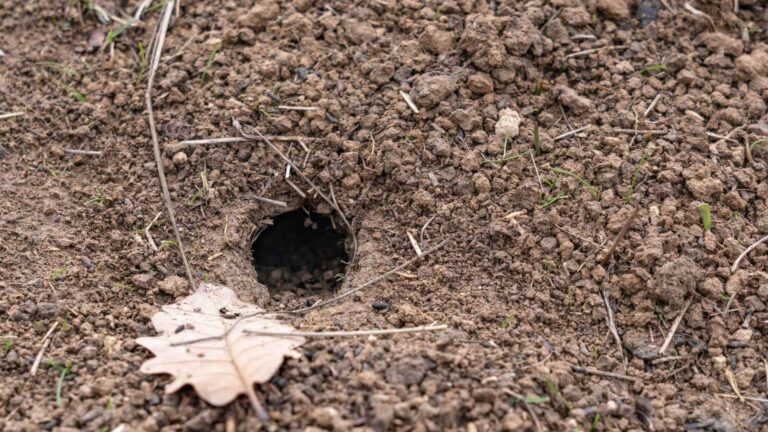
Wasp Encounters and Safety Tips
Encounters with wasps in Texas are inevitable, especially during their peak activity periods. Here are some safety tips:
- Remain calm and avoid swatting at wasps. Sudden movements can provoke them to sting.
- Move slowly away from the area and allow the wasp to fly away.
- If stung, remove the stinger with tweezers and apply a cold compress to reduce swelling. Seek medical attention if you experience allergic reactions.
- To minimize accidental stings, avoid wearing bright colors and strong perfumes outdoors. Keep food and drinks covered during picnics or outdoor events.
Wasp Control and Management in Texas

While prevention is key to keeping wasps at bay, wasp encounters and nest discoveries are inevitable sometimes. Here’s how to approach wasp control and management in Texas:
Prevention Strategies
- Seal entry points: Carefully inspect the exterior of your home and seal any cracks, gaps, or holes around windows, doors, foundations, and utility lines. This helps prevent wasps from establishing nests within your walls or attic.
- Eliminate attractants: Wasps are drawn to sweet smells and readily available food sources. Keep trash cans tightly sealed, clean up spills involving sugary drinks or fruits, and avoid leaving pet food bowls outside for extended periods.
- Regular inspections: During spring and summer, regularly inspect your property for signs of wasp activity, including nests or hovering wasps near potential nesting sites. Early detection allows for easier removal before wasp populations grow.
When to Call a Professional
While some small, solitary wasp nests located in isolated areas might be manageable on your own, consider seeking professional help in these scenarios:
- Large or established nests: Large nests or those situated near entryways, patios, or high-traffic areas pose a significant stinging risk. Professionals have the proper equipment and expertise to safely remove these nests.
- Ground nests: Cicada killer burrows or nests located near foundations can be tricky to handle due to the wasps’ underground activity. Professionals can effectively locate and eliminate these nests.
- Sting allergy concerns: If you or someone in your household has a known allergy to wasp stings, avoid approaching any wasp nest altogether. Call a professional to ensure safe and effective removal.
Schedule a pest control consultation to secure your home today.
Wrap-Up: Buzzing Insights on Different Wasps in Texas

As a pest control expert, I encourage you to be aware of the “different wasps in Texas” and their behaviors. Knowledge is power when dealing with these fascinating creatures.
By following the tips provided, you can minimize wasp-related problems and coexist peacefully with these beneficial, albeit sometimes intimidating, insects. Remember, responsible and informed actions are key to managing wasp populations in Texas.
Frequently Asked Questions About Different Wasps in Texas
What kind of wasps are in Texas?
Texas is home to various types of wasps, including yellow jackets, paper wasps, mud daubers, cicada killers, and tarantula hawks, each with unique characteristics and behaviors.
Which Texas wasp has the worst sting?
Among Texas wasps, the tarantula hawk is known for having one of the most painful stings, causing intense discomfort and localized swelling.
Are Texas paper wasps aggressive?
Texas paper wasps can be aggressive if they feel threatened or their nest is disturbed, often defending their territory with stings.
What is the Texas killer wasp?
The Texas killer wasp, also known as the tarantula hawk, is a large wasp species known for preying on tarantulas and delivering potent stings.
References
https://en.wikipedia.org/wiki/Yellowjacket
https://en.wikipedia.org/wiki/Tarantula_hawk